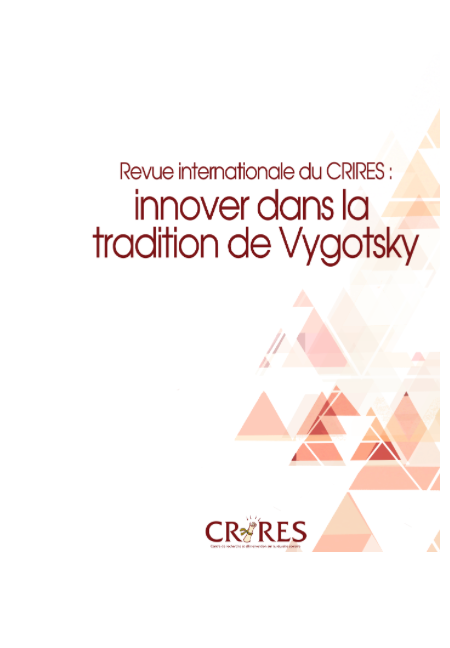L’apprentissage expansif et la construction de l’identité de jeunes à travers la réalisation d’un documentaire scientifique : un projet d’agentivité transformatrice
DOI :
https://doi.org/10.51657/ric.v3i1.41024Mots-clés :
apprentissage expansif, création, construction de l’identité, club scientifique, activités parascolaires, école secondaire, réalisation vidéo, multimédiaRésumé
Inspirés par les travaux de Vygotsky, nous examinons l’apprentissage selon une vision de l’individu comme créateur et agent de changement. En nous appuyant sur ses éléments clés de la théorie socioculturelle, nous entendons explorer ce qu’un tel concept, jumelé à celui de construction de l’identité, peut sous-tendre dans le cadre du fonctionnement d’un club scientifique parascolaire mis sur pied collectivement, et proposant des activités destinées à des jeunes d’une école secondaire. Nous nous intéressons plus particulièrement au processus de réalisation en commun d’un documentaire vidéo portant sur les sciences, processus qui s’est étalé sur douze semaines. Nous entendons ainsi explorer des formes d’implication en sciences qui ne correspondent pas aux modèles normatifs typiques des sciences enseignées à l’école. Nous voulons du coup montrer dans quelle mesure une telle implication favorise l’apprentissage créatif et la construction de l’identité en matière de sciences ainsi que l’émergence d’une communauté d’apprentissage propice autant à l’agentivité transformatrice des jeunes qu’à celle des animateurs.
Références
Bang, M., Warren, B., Rosebery, A. S., & Medin, D. (2012). Desettling expectations in science. Human Development, 55, 302-318.
Barma, S. (2014). Mot de la rédaction : Le CRIRES et l’innovation sociale en éducation. Revue internationale du CRIRES : innover dans la tradition de Vygotsky, 2(1), 1-7.
Barron, B., Gomez, K., Pinkard, N., & Martin, C. K. (2014). The digital youth network. Cultivating digital media citizenship in urban communities. Cambridge, MA : MIT Press.
Barron, B. (2007). Video as a tool to advance understanding of learning and development in peer, family, and other informal contexts. Dans R. Goldman, R. Pea, B. Barron, & S. J. Derry (Eds.), Video research in the learning sciences (pp. 159-187). Mahway, NJ: Lawrence Erlbaum Associates.
Calabrese Barton, A., & Tan, E. (2008). Where da heat go? Developing critical science agency through student-directed science documentaries on urban heat islands. Paper presented at the annual meetings of the American Educational Research Association, New York.
Cole, M. (and the Distributed Literacy Consortium) (2006). The fifth dimension: An afterschool program built on diversity. New York : Russell Sage Foundation.
Engeström, Y. (1987). Learning by expanding: An activity-theoretical approach to developmental research. Helsinki, Finland: Orienta-Konsultit.
Engeström, Y. (1996). Non scolae sed vitae discimus: Toward overcoming the encapsulation of school learning. Dans H. Daniels (Ed.), An introduction to Vygotsky (pp. 151-170). New Yor, NY: Routledge.
Engeström, Y. (1999). Expansive visibilization of work: An activity-theoretical perspective. Computer Supported Comparative Work, 8, 63-93.
Holland, D., Lachicotte, W., Skinner, D., & Cain, C. (1998). Identity and agency in cultural worlds. Cambridge, MA : Harvard University Press.
Hull, G., & Katz, M.-L. (2006). Crafting an agentive self: Case studies of digital storytelling. Research in Teaching of English, 41(1), 43-81.
Kafai, Y. B., & Burke, Q. (2014). Connected code: Why children need to learn programming. Cambridge, MA : MIT Press.
Kafai, Y. B., Peppler, K. A., & Chapman, R. N. (2009). The computer clubhouse: constructionism and creativity in youth communities. New York, NY : Teachers College Press.
Kincheloe, J. L., & Berry, K. S. (2004). Rigour and complexity in educational research: Conceptualizing the bricolage. McGraw Hill, England: Open University Press.
Nasir, N. (2012). Racialized identities: Race and achievement for African-American youth. Stanford University Press.
Papert, S. (1980). Mindstorms: Children, computers and powerful ideas. New York, NY : Basic Books.
Resnick, M. (2007). Sowing the seeds for a more creative society. Learning and Learning with Technology (ISTE), January, 18-22.
Rogers, T., Winters, K.-L., LaMonde, A.-M., & Perry, M. (2010). From image to ideology: analysing shifting identity positions of marginalized youth across the cultural sites of video production. Pedagogies : An International Journal, 5(4), 298-312.
Sannino, A., Daniels, H., & Gutiérrez, K. (Eds.) (2009). Learning and expanding with activity theory. New York, NY : Cambridge University Press.
Spradley, J. P. (1980). Participant observation. New York, NY : Harcourt Brace Jovanovich. Tan, E., & Calabrese Barton, A. (2012). Empowering science and mathematics education in urban schools. Chicago, IL : University of Chicago Press.
Vasquez, O. A. (2003). La Clase Magica: Imagining optimal possibilities in a bilingual community of learners. Mahwah, NJ: Lawrence Erlbaum Associates.
Vygotsky, L. (1987) (Ed. R. W. Rieber & A. S. Carton). The collected works of L.S. Vygotsky. Volume 1 : Problems of general psychology. New York : Plenum Press.
Yamazumi, K. (2009). Expansive agency in multi-activity collaboration. Dans A. Sannino, H. Daniels, &
K. D. Gutiérrez (Eds.), Learning and expanding with activity theory (pp. 212-227). New York, NY : Cambridge University Press.
Yvon, F., & Zinchenko, Y. (dir.) (trad. Par L. Chaiguerova, sous la direction de F. Sève) (2011). Vygotsky, une théorie du développement et de l’éducation. Recueil de textes et commentaires. MGU, Moscou. Récupéré de : www.unige.ch/fapse/leforcas/Publications/Vygotsky_1-428.pdf
Téléchargements
Publié
Numéro
Rubrique
Licence
© Jrène Rahm, Émilie Boulange, Issac Hebert, Gwénaëlle Journet, Audrey Lachaîne 2015

Cette œuvre est sous licence Creative Commons Attribution - Pas d'Utilisation Commerciale - Pas de Modification 4.0 International.

